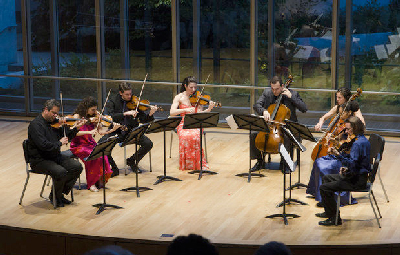by Timothy Robson

After some introductory remarks by Frank Cohen and Diana Cohen, the festival directors, the concert opened with a Baroque musical curiosity, Heinrich Ignaz Franz von Biber’s Battalia for ten string instruments and harpsichord continuo (3 violins, 4 violas, 2 double basses and harpsichord). In eight short movements, Biber depicts scenes of an army preparing for battle, fighting, and finally lamenting the lost and wounded soldiers. There are many “advanced” instrumental techniques: various kinds of plucking and bowing the strings, including the double bass wrapping a piece of paper around the strings and then bouncing his bow to create a sound that simulates that of a snare drum.
Biber remembered that soldiers like to drink and carouse; the second movement, “For dissolute company with all manner of humors,” is a complex, simultaneous layering of eight different drinking songs upon each other, with no regard for the dissonance that ensues. It is interesting to note that Biber’s 1673 musical expression took place about 250 years before Charles Ives’s more famous similar experiments in layering disparate musical tunes. The ten players created a reasonable facsimile of Baroque musical style on their modern instruments, with little vibrato and close attention to the stress on dissonances and their resolution.
Often when one hears a piece of new music for the first time, the question remains at the end, was it worth the effort? In the case of young American composer Andrew Norman’s 2010 The Companion Guide to Rome, the answer is a resounding “Yes!” For violin, viola and cello (Diana Cohen, Dimitri Murrath and Julie Albers, respectively, in this performance), Norman has created musical portraits of nine Roman churches titled with the names of saints associated with the churches. The sound world that he has created for these (mostly) short movements is arresting and virtuosic, pushing these very proficient players to their limits. There are some techniques that recur throughout the suite: very gently scraping the bow over the strings so lightly that the sound is virtually inaudible; layering of musical motives among the three instruments in endless, slightly modified repetitions; using glissandi as a melodic device; dramatic, instantaneous changes in dynamic level from inaudible to furious fortissimo.
There are also elements of theatricality: for “Susanna,” the violist stands with his back to the other two players, playing long, barely audible noises from the strings of his instruments; suddenly there is a very loud passage, similar in style to a solo string movement by Bach, before returning to the very quiet music. In “Cecilia,” for solo violin, Ms. Cohen removed herself to face the back glass curtain wall of Mixon Hall. While the music progressed with a lavish coloratura aria that gradually ascended higher and higher into the violin range, as well as ever softer, we saw Ms. Cohen’s image reflected twice in the double layer of glass in the gradual twilight outdoors. Legend has it that St. Cecilia sang to the Lord in her heart on her wedding day that her marriage would not be consummated and that she would remain a virgin. The musical and theatrical effect was breathtaking.
The closing movement of the Companion Guide evokes the church of Santa Sabina, who was martyred for an act of charity in rescuing the remains of her servant and giving them a Christian burial. Norman’s “Sabina” is the longest movement of the nine, and most developed musically. it begins quietly for music in the viola and cello, then all three instruments transform the music featuring “Copland-ish” open fifth intervals, layering ever more complexity as the movement progresses, until an extended ecstatic and tonal climax. The movement ends softly on unison notes that are traded back and forth among the three players, another example of the immense control that Ms. Cohen, Mr. Murrath and Ms. Albers posssess. Andrew Norman’s Companion Guide deserves to be heard again and again. He is a composer to watch as his career progresses.
After intermission, ChamberFest returned to the heart of the nineteenth-century chamber repertoire with Johannes Brahms’s Sextet for two violins, two violas and two cellos in G, op. 36, with performers from earlier in the concert, plus Robert deMaine, cello. Violist Dimitri Murrath must be singled out as perhaps the hardest working musician in the festival, performing at many of the concerts, including all three pieces this evening.
After the drama of Andrew Norman’s work, it was a pleasure to sit back and enjoy the splendid performance of Brahms’ gracious sextet. The Scherzo, with its folk-like melody and brash central section that reminded one of Brahms’s Hungarian Dances, and the third Adagio movement, a set of variations on a harmonic sequence, were especially appealing here. The final movement, marked Poco Allegro, showed the skills of the performers assembled for ChamberFest Cleveland.
It is probably safe to assume that these concerts are done on a limited rehearsal schedule; however, this group seemed to be performing as one organism, as if they had been playing together every day for months or years. One can only wish that more concert presenters had the imagination to put together programs such as this: old and interesting; new and thrilling; and familiar at top notch.
Photo by Gary Adams.
Published on ClevelandClassical.com June 28, 2013
Click here for a printable version of this article.



